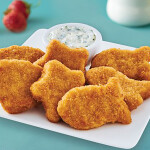Seafood Handbook Finfish Page
The Seafood Handbook is the most comprehensive seafood directory available online. Featuring more than 100 of the most common seafood species in the U.S. market, the Seafood Handbook is the ultimate guide to seafood sourcing and preparation, brought to you by the editors of SeaFood Business magazine. And it’s free!
For each type of seafood species, there is a comprehensive overview of the item, its origin, history, availability, product attributes, nutritional value and cooking tips, along with an original hand-drawn depiction.
Explore Finfish by searching here:
Black sea bass, a small, plump fish related to grouper, is one of the most important commercial bass species. These bass begin life as males and become females between the ages of 2 and 5. Attractive fish, they lend themselves to display in live tanks. Mature animals have an even pattern of white… Read More
Sustainability is certainly not an issue with the common carp, which is farmed and fished in freshwater worldwide. Native to Asia, the species eventually made its way into Europe and was introduced in the 1800s to the United States, where it’s now considered an invasive species. Processing… Read More
The prehistoric sturgeon was once abundant in the United States, consumed on both coasts and exported to Europe, where the roe was processed as caviar. By the end of the 19th century, stocks had collapsed, and today, wild fish are almost impossible to obtain. Of the seven North American species of… Read More
American shad, the largest member of the herring family, is widely considered the tastiest of the world’s 31 shad species; the species name (sapidissima) means “most delicious.” Shad is a seasonal novelty on restaurant menus, and shad bakes are a rite of spring in many Mid-Atlantic… Read More
More than 20 different species within the Engraulidae family are marketed under the name anchovy. The U.S. Food and Drug Administration’s Fish List recognizes five genus groups: Anchoa, Anchoviella, Cetengraulis, Engraulis and Stolephorus. The anchovy best known in culinary circles is Engraulis… Read More
The “can-friendly” pink is the smallest and most plentiful of the wild salmon, accounting for the lion’s share of the canned pack. That pink salmon mostly winds up in cans is due partly to its habit of showing up in huge schools during short periods of time and requiring rapid, high-volume… Read More
Yellowtail is a confusing name, as it can apply to flounder, tuna and sole. It’s also the common name for several species of amberjack, sleek migratory tuna-like fish found off both U.S. coasts. The most valuable member of this family is the yellowtail farmed in Japan and featured in U.S. sushi… Read More
Cobia is a relative newcomer to the U.S. market, with limited distribution from a handful of aquaculture operations. However, proponents of cobia farming believe it could be the next tilapia, though with more character and upscale appeal. The species is a proven candidate for aquaculture, as it… Read More
Yellowfin, as its name implies, is distinguished from other tunas by a long, bright-yellow dorsal fin and a yellow strip down its side. It’s also more slender than bluefin. With its flashy markings, the yellowfin tuna is especially impressive at night. Fishermen say that when watching yellowfin… Read More
The name red snapper has been foisted off on just about any fish that is red. However, the FDA insists that only American red snapper, L. campechanus, can be legally shipped interstate bearing the authentic red snapper label. Beware of “snapper” sold on the West Coast; it could actually be… Read More















